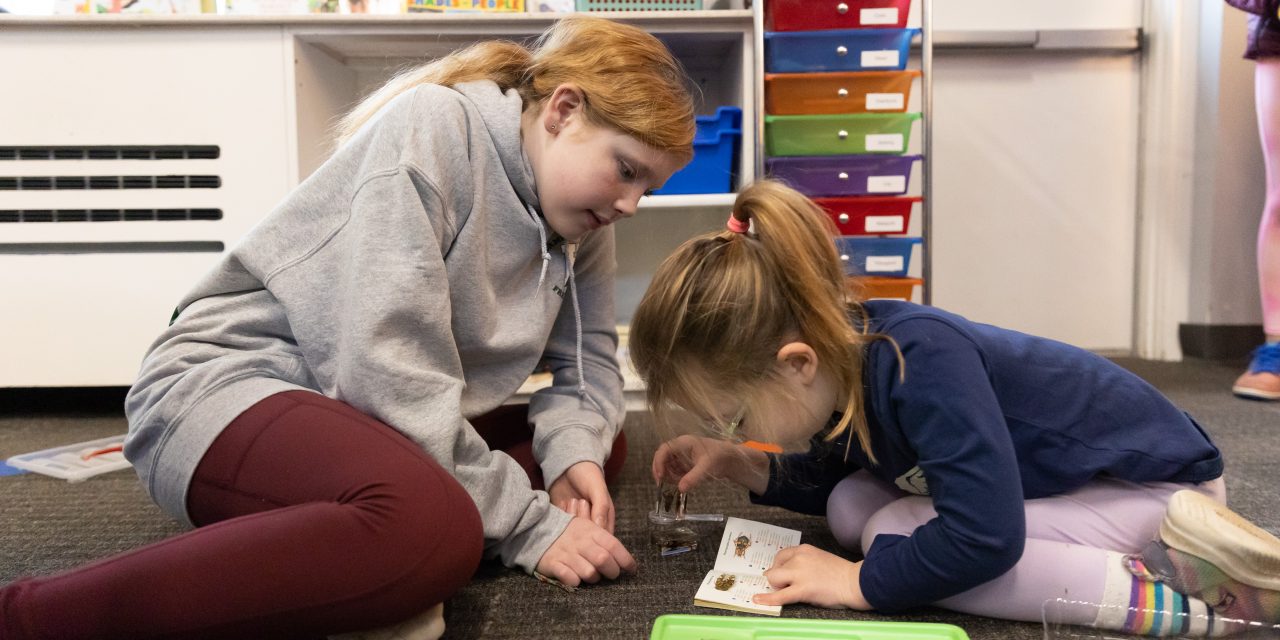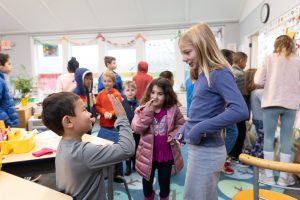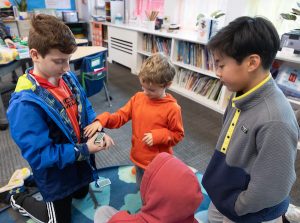
The Best of Buddies

Milton’s buddy program builds a lifetime of skills.
Story by Sarah Abrams
Photography by Evan Scales ’17
On a warm, sunny fall day, fifth- graders Sophie Kalin and Emily Munko are eager to explain what makes Milton’s buddy program so special.
For Sophie, “It brings back memories of when I was in kindergarten,” and for Emily, “I just love hanging out with the young kids.” Today, they watch as their kindergarten buddy Malachi Camp- bell scoops up wood chips off the ground, carefully arranging them around the legs of one of the playground’s benches. He wants to make sure, he explains, that the bench doesn’t wobble when someone sits down.
While Malachi and his fifth-grade buddies work on the bench, others on Milton’s Lower School playground are playing hide-and-seek or T-ball, swinging on the jungle gym, or just chatting and laughing. They are all thrilled to be outside and with one another.
The buddy program, which pairs the Lower School’s kindergarten students with fifth-grade students for unstructured play once a week, has been hugely successful for more than three decades, says fifth-grade teacher Jennifer Katsoulis, who has been teaching at Milton for 18 years. Over the years, the program has forged friendships that often last well beyond the students’ first year together. “When you see your buddy later,” says a fifth-grader recalling when she was a kindergartner, “there’s a special feeling that you have. After all these years, there’s this bond.”
 The program evolves each year pretty organically, says Katsoulis. Each week for half an hour, the Lower School’s fifth-graders visit the kindergarten classes. They read books together, play math games, work on art projects, or play with Legos, blocks, and Play-Doh. In good weather, they play outside.
The program evolves each year pretty organically, says Katsoulis. Each week for half an hour, the Lower School’s fifth-graders visit the kindergarten classes. They read books together, play math games, work on art projects, or play with Legos, blocks, and Play-Doh. In good weather, they play outside.
“We’re not telling them what activity to do,” Katsoulis says. “It’s really up to them to figure that out, and that’s an important skill, to not have to be always told, ‘Here’s the next thing we’re doing.’” They also link up during school wide events— at assemblies, the Veterans Day flagpole ceremony, pep rallies, and other school performances.
Partnerships are not assigned. As the students get to know one another over the course of several weeks, relationships begin to emerge. “There might be a couple of kids who are naturally a little hesitant or shy, and they magically find each other,” says Katsoulis. “It’s nice to see. It’s really about finding someone you connect and click with. For them to be able to go through that process is kind of cool to watch.”
Kindergarten teacher Kiana Gibson loves watching as the relationships between the school’s youngest students and the fifth-graders build over the course of the year. “They get to know each other’s likes and dislikes,” she says.
“The other day I loved watching a few kids play T-ball,” Gibson says. “The kindergartner wasn’t sure how to hold the bat. His buddy was so patient as he helped him develop this new skill. It’s a really nice bond that they built.”
The value of a program like this, the teachers say, cannot be overestimated. “The kindergarten program centers on building the students’ social/emotional skills,” says another kindergarten teacher, Martha Slocum. “The students are going to get the academics as they go through Milton, but if they know how to meet and play with a friend and maintain that relationship over an entire year, they’re going to use that later—when they’re a lab partner in high school or when they’re in a board meeting in the office as an adult. All these skills that we’re imparting to them now are lifelong skills.”
And the program gives fifth-graders an opportunity to serve as leaders and role models. “They are old enough to navigate and be flexible and help their buddies get to know them and other people,” Katsoulis says. “They do a really nice job of taking on that role. ‘Here’s our school and here’s our community and have you met this big buddy?’ It definitely plays out during recess time.”
“Many of the fifth-graders were here in kindergarten,” adds Slocum. “When they come back, they’re full of joy in returning to their former classroom and being there in a different capacity. Now they’re a mentor; now someone is looking up to them. They’re taking that five-year- old through some of the steps they had to go through when they were a kindergartner. That bond is really quite strong.”
Amy Criswell, the Lower School’s new principal, has enjoyed observing how the buddies interact with one another—both inside and out- side the classroom. “The fifth-graders seem just as excited to see the kindergartners as the kindergartners are to see the fifth-graders,” she says. “Even when they’re out and about on campus, they have their radar out for their buddies. When they pass each other on campus, they’re running up and giving high-fives to each other or getting quick snuggles.”
Criswell is delighted that Middle School Principal Steven Bertozzi and the sixth-grade teachers have continued the program to include first- and sixth-graders. The former kindergarten/fifth-grade buddies—now first and sixth graders—read together. “The joyful energy is just amazing,” says Criswell. “The sixth-graders flood into the first and second grade classrooms and curl up reading books together.”
As recess comes to an end, Malachi is still at work, making certain the bench is more secure than when he began his project. When it is suggested he might one day become an engineer, he never looks up, but continues his efforts to stabilize the bench. “I am going to be an engineer,” he says quietly.




